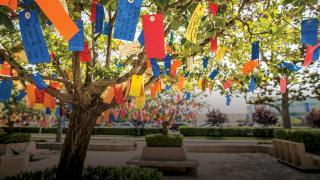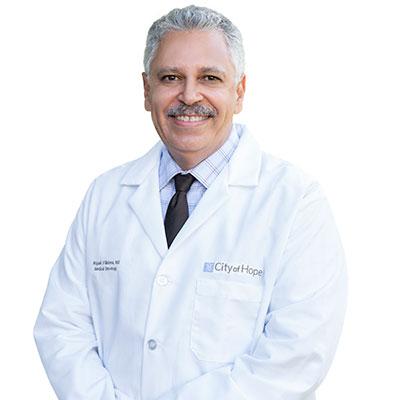“Bullets were flying.”
Hardly the answer you expect when asking the question, “Why did you become a doctor?”
But for Miguel Villalona-Calero, M.D., a world-renowned oncologist and researcher who oversees all of City of Hope’s early-stage clinical trials, gunfire, indirectly at least, did play a role.
In 1965, Villalona-Calero, the son of a school teacher and customs inspector in Santo Domingo, Dominican Republic, was 4 years old. Civil war was raging outside of his window, and 22,000 U.S. troops had been sent in.
During this violent time, Villalona-Calero’s older brother became ill. The family pediatrician risked his own life to make a house call. “He came to our home even though bullets were flying,” recalled Villalona-Calero. That simple act of courage and dedication made a lasting impression. The young Villalona-Calero knew at that moment that he wanted to be a doctor.
His interest in cancer research came a decade later, when an eighth grade classmate developed osteosarcoma and had an arm amputated, but later died when the cancer spread and chemotherapy — still experimental at the time — was unavailable. Meanwhile, in the U.S., young Edward Kennedy Jr., son of the Massachusetts senator, was being treated for the identical disease. He received chemotherapy and survived. “I saw that research can make a difference,” said Villalona-Calero. “I decided to study to cure cancer.
“And I never looked back.”
But others were looking at him.
“He was hungry,” recalled Michael Caligiuri, M.D., president of City of Hope National Medical Center and the Deana and Steve Campbell Physician-in-Chief Distinguished Chair. He first spotted the eager “young attending” in 1990 at Roswell Park Cancer Institute in Buffalo, New York, and “I never took my eye off him.” Caligiuri would go on to recruit Villalona-Calero for a position at The Ohio State University and, in 2020, brought him to City of Hope.
He's Come a Long Way
He’s come a long way from the hungry kid fresh out of medical school and the young resident treating desperately ill patients at Kings County Hospital in Brooklyn, New York, at the height of the AIDS epidemic. “That’s when I grew up, from a mama’s boy into a man,” he said.
He’s a triple threat,” added Caligiuri, “an outstanding doctor, teacher and investigator.”
“Outstanding” may be an understatement.
Specializing in lung cancer (“because it needs the most work since it’s such a big killer,” he says), Villalona-Calero focuses his research on finding new targets that drive cancer, putting him at the leading edge of oncology’s new universe, where cancer is recognized as multiple diseases, no two tumors are the same and genomics and immunotherapy take the lead in developing more effective treatments.
His output over the last 30 years is prodigious: Some 120 published papers, scores of clinical trials and a “stature and recognition” that Caligiuri says made Villalona-Calero an ideal candidate to head up City of Hope’s early phase therapeutics program. “We went after him hard. We knew he’d be a superstar here.”
'Exciting' Trials
Since arriving at City of Hope, Villalona-Calero has plunged in, serving as principal investigator in several “exciting” trials looking at inhibitors of the CDK 2 and 9 proteins present in tumors. “We’re developing treatments for targets we couldn’t find before,” he said. Early results are encouraging, he says. He’s about to initiate a project with re-engineered so-called “natural killer” cells to attack cancer.
He’s also attacking a situation he considers “appalling”: a lack of diversity in the medical community. He crusades for better representation of ethnicities and cultures in clinical trial recruitment, and he has mentored a long list of budding clinicians and scientists from diverse backgrounds, winning awards for his efforts, including one in 2017 from the National Cancer Institute’s Center to Reduce Cancer Health Disparities.
“Diversity goes beyond skin color. It also applies to poverty,” said Villalona-Calero, recalling his own circumstances. “When you’re educated in the third world, you’re exposed to poverty like you’ve never seen before. So being able to offer advice and help is something that should come as second nature to someone like me.”
He may be modest about it, but Caligiuri has seen his colleague’s efforts up close. “He is super dedicated to his country and origins,” he observed. “Whether it’s teaching or treating patients, he’s never forgotten his roots, serving Dominican patients here in the U.S. as well as in the Dominican Republic.” Indeed, one undoubtedly grateful patient is president of the medical school Villalona-Calero attended in Santo Domingo. “He’s now in remission,” Villalona-Calero said with a smile.
He smiles, too, when thinking about his new home at City of Hope, where he revels in the resources and delights in the attitude that permeates the institution. He describes that attitude simply:
“There is always hope.”

